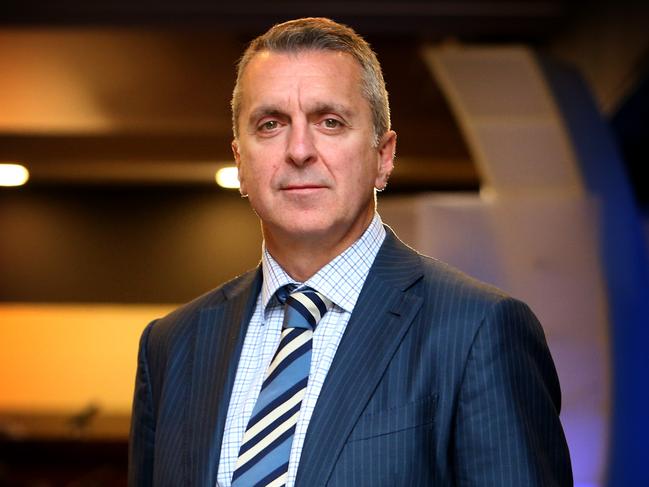Where you pay $15 more for medicine in Sydney, NSW because of where you live
Some Sydneysiders and parts of greater NSW are paying nearly four times more for vital medicines because of their home address. See the list of drugs and suburbs facing higher prices.

NSW
Don't miss out on the headlines from NSW. Followed categories will be added to My News.
- The ‘promising’ chemist items that could treat COVID-19
- 165 vaccine hopes that could save the world from COVID-19
Exclusive: Patients are paying nearly four times more for their medicines simply because of where they live, a News Corp Australia investigation has found.
The difference in price is the result of laws that give pharmacists a monopoly on owning chemist shops, while at the same time preventing new chemists opening within 1.5 kilometres of existing businesses and banning supermarkets from selling the drugs.
Federal government rules also mean a new pharmacy has to be within 500 metres of a full-time prescribing medical practitioner and a small supermarket, or within 500 metres of a large supermarket.
Despite three government reviews finding these location rules punish consumers, push up their medicine prices and called on them to be ended – the federal government stepped in last year to pass a new law overriding a sunset clause which would have seen the rules expire this year.
Instead the rules have turned pharmacies into multimillion-dollar businesses, with consumers left paying as much as $15 more for the exact same medicine depending on where they live.
And it is patients in regional towns left footing the biggest bill.
A News Corp Australia survey of more than 40 chemists across NSW, Victoria, South Australia and Queensland showed a massive gap in the price people are paying for the 10 most prescribed medicines on the Pharmaceutical Benefits Scheme.
In NSW the cholesterol beating medicine Atorvastatin costs a general patient just $5.99 at Chemist Warehouse but $20.87 at the Michael O’Reilly Pharmacy in Wagga Wagga, $20 in Gilgandra, $7 at Rumore’s Pharmacy in Bankstown and $12.95 at Ralph’s Pharmacy in Campbelltown.
In Victoria, Rosuvastatin costs $23.20 in South Melbourne, $23 in Richmond, $9.95 in Brunswick and $8.99 at Chemist Warehouse in Prahran.
That same medicine costs Queenslanders $23.29 at AFS Pharmacies in Rockhampton, $18 at The Friendlies Chemist in Townsville, and $8.99 at Chemist Warehouse in Brisbane.
In South Australia, Rosuvastatin costs $17.99 at Waikerie Pharmacy, but $14.99 at Amcal Plus in Loxton, $11.50 at Priceline Pharmacy in Mount Gambier and Port Pirie and $8.99 at Murray Bridge at Chemist Warehouse.
We even found the same pharmacy owner charging three separate prices for this medicine in three different outlets.
The president of the Pharmacy Guild of Australia George Tambassis charges $12.95 for Rosuvatatin at his Vermont pharmacy, $11.50 at his Cowes pharmacy but just $9.95 at his Brunswick chemist.
“The idea that different businesses with different costs, wages, staff levels and rental overheads should all charge the same price in an open market is frankly unrealistic.” Mr Tambassis told News Corp.

For pensioners and welfare recipients who pay a maximum of $6.60 per script under our medicines subsidy scheme the price difference is smaller at around $1 per script.
A survey by Bastion Insights found more than four in 10 (43 per cent) people never compare prices when shopping for medicines, while 39 per cent sometimes compared prices and only 15 per cent always compared prices.
Industry sources have told News Corp medicine wholesalers suggest a range of different prices for their medicines based on how close the chemist is to a competitor.
The price is higher if there is no competitor pharmacy in the town or suburb and cheapest if there is a discount chemist nearby.
Discount pharmacy chain Chemist Warehouse has a list of 44 towns where residents paying high prices for medicines have written to the company begging for a discount pharmacy in their town.
The chain says government location rules that prevent new pharmacies opening within 1.5 kilometres of an existing pharmacy prevent that happening.
“They should be relabelled “stop Chemist Warehouse” rules,” Chemist Warehouse CEO Mario Tascone said.
Last year a Chemist Warehouse survey found 65 per cent of people had travelled to another town to visit a pharmacy, while more than 85 per cent drove as far as 50kms because of pricing.
For people with chronic conditions and on multiple medications the high costs of prescriptions can be crippling.
The Pharmacy Guild justifies the anti-competitive rules claiming “the Location Rules were introduced by Government to ensure a viable network, so patients could get access to PBS medicines wherever they live”.
“For example, modelling shows that Australians living in urban areas, such as Melbourne, are generally with 2.5 kilometres of a community pharmacy. That is no accident of the market – it is good public policy,” Mr Tambasis said.

In practice they deny regional towns access to a cheaper discount chemist by allowing the same pharmacist to own all the chemists thereby restricting competition.
Many pharmacies are no longer owned by the pharmacists who work in them. They are instead paid as little as $30 an hour despite having studied for five years to obtain their university degree.
Professional Pharmacists Australia president Geoff March said pharmacy graduates “are the equal lowest paid of any degree qualified profession (alongside artists).”
“To make things worse, antiquated ‘location rules’ effectively lock employees out from owning their own pharmacy, leaving them stuck in a cycle of low pay and no real hope for the future.”
A recent survey found half were planning on leaving the profession, he said.
“When protection rackets for business are allowed to influence independent public policy reviews in critical areas of policy like medicines, we have a major problem in this country – one worthy of investigation,” he said.
POWERFUL GROUP PUSHING UP MEDICINE PRICES
It’s renowned as the most powerful lobby group in the country but you’ve probably never heard of the Pharmacy Guild of Australia.
The employer organisation represents the nation’s 3500 pharmacy owners and every five years it gets to determine how much you pay for medicines on the taxpayer funded medicines subsidy scheme.
The Guild has donated more than $1.5 million to political parties in the past five years including a staggering $773,000 in 2019, and it appears to pay big dividends.
Political leaders are happy to be photographed wearing Pharmacy Guild ties and every election both major parties sign a letter committing not to open chemists to competition from supermarkets.
The Guild’s political clout is powerfully demonstrated in a new five year deal negotiated with the federal government that sets the price we pay for medicine.
Under the agreement that came into effect on July 1, the nation’s chemists will have their incomes guaranteed by the taxpayer even if the number of prescriptions they dispense falls.
Health Minister Greg Hunt told the Guild’s annual parliamentary dinner last year this ‘money for nothing’ clause in the new Seventh Community Pharmacy Agreement was about providing chemists “bankable certainty over your asset”.
Under a similar arrangement in the 2017 budget, the Pharmacy Guild received a $200 million taxpayer funded handout to make up for the fact that there were fewer prescriptions filled that year than they anticipated.
When Mr Hunt tried to save consumers $240 a year by allowing them to get their scripts filled six times a year instead of 12 times, the Guild took out a furious full page ad in national newspapers.
The measure that would have benefited millions of consumers and saved the taxpayer money was quickly scrapped.
In recent years the Guild has angered doctors by moving in on their turf winning government approval to deliver flu vaccinations and in some states childhood vaccinations.
Many of these vaccinations have never been entered into the nation’s vaccination record scheme.
In Queensland chemists are trialling not just dispensing but prescribing medicines for urinary tract infections even though there is a clear conflict of interest with the person who makes money from the script deciding if you need it.
MORE NEWS
New plan to save Aussie doctors and how it affects you
New way to get prescription drugs without leaving home
Vic faces 700 COVID patients, one new hospital a week
Aussie heart attack drug could help COVID-19 patients
Chemists are not qualified to diagnose illness and could miss more serious causes of a medical problem like cancer or kidney disease and handing out antibiotics could contribute to antibiotic resistance, doctors groups argue.
No other small business gets a government guaranteed income, a monopoly that guarantees only a pharmacist can own a chemist and protection from competition by supermarkets or even rival pharmacies who can’t locate within 1.5 kilometres of an existing business.
Why is the Guild so powerful?
With a pharmacy in almost every suburb that has regular contact with families and, crucially, older voters, chemists can and have used their shopfronts for political campaigns.
“Our contributions to political parties to attend their events are declared, on the public record, and published by the Australian Electoral Commission,” the Pharmacy Guild’s national president George Tambassis said.

